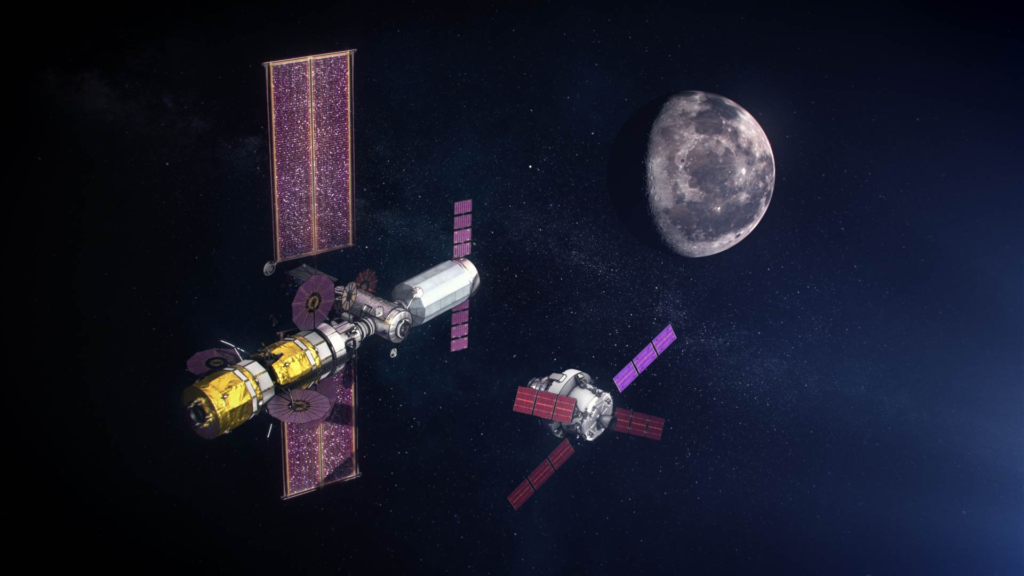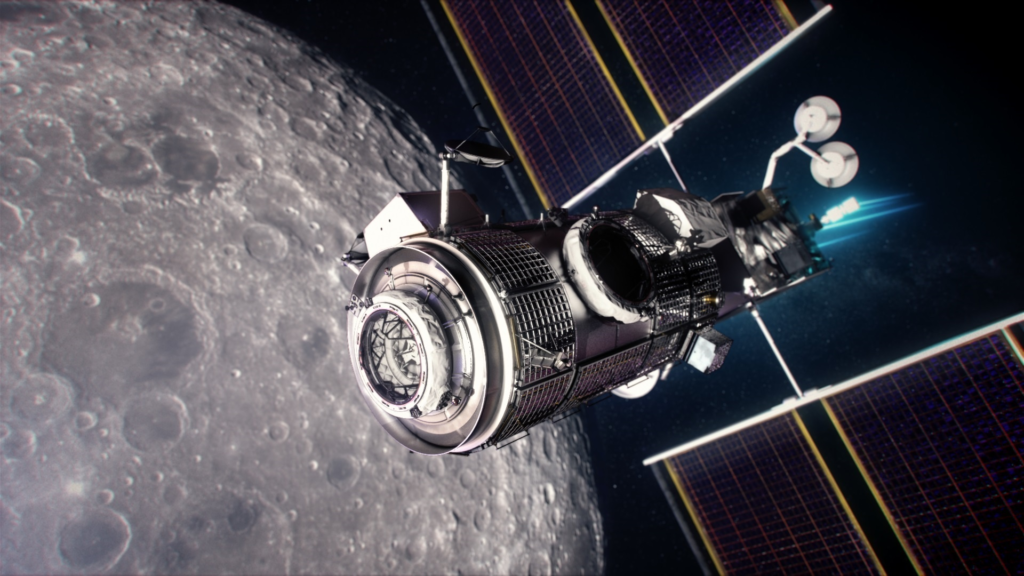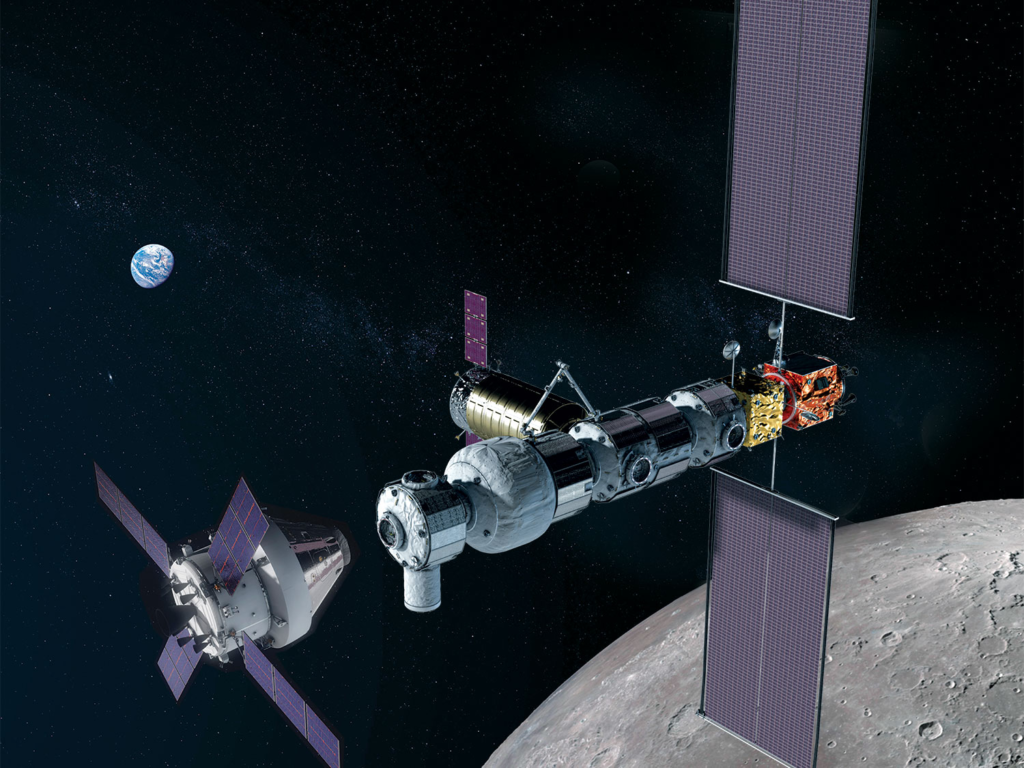
The Challenge With Building NASA’s Lunar Space Station
At this point, NASA is committed to the Gateway space station with a significant amount of time and money already invested in the project. By now, it’s also far more than just an idea but physical hardware taking shape around the country. This being said, there are a few concerns regarding its future schedule and the complexities of creating a lunar space station.
Just recently Northrop Grumman, the company contracted to create the HALO Module, took a $36 million charge on its fixed price contract. They cited changes in the mission plan among other things as the reason for the price cut. For example, new information suggests that the mission plan to launch both the HALO and PPE modules together on a Falcon Heavy is causing problems.
Under the contract, Northrop Grumman will complete the design and development activity currently underway and will also be responsible for integrating HALO with the Power and Propulsion Element provided by Maxar Technologies. Here I will go more in-depth into some of the station complications, possible delays, Gateway’s timeline, and more.
A Difficult Project

Around two years ago in July 2021, Northrop Grumman finalized a contract with NASA to provide the Habitation and Logistics Outpost (HALO) module for NASA’s Gateway under a $935 million fixed price contract. Fixed price contracts simply pay the company when they reach the agreed upon milestone. However, in an earnings call, Kathy Warden, chief executive of Northrop Grumman, said earlier work on HALO to mature the design had been done on cost-plus contracts before the fixed-price contract two years ago to produce HALO. Cost plus contracts generally pay for the company’s expenses plus a fee.
Not long ago, when talking about fixed price contracts NASA Administrator Bill Nelson said, “I believe that is the plan that can bring us all the value of competition. You get it done with that competitive spirit. You get it done cheaper, and that allows us to move away from what has been a plague on us in the past, which is a cost-plus contract, and move to an existing contractual price.”
Despite this, Northrop Grumman’s chief executive commented, “We think that is best applied for commercial items or production programs with stable requirements and mature designs,” she said of fixed-price contracts. “As it’s turning out on the HALO program, the requirements are not as stable as we or the government anticipated, and we’re working with them to address that change management as we go forward” she said. In other words, they believe that the contract should be cost plus rather than fixed because too many variables are changing.
While not ideal, the reality is a lot of things have changed regarding the Gateway station in only the past few years. One major change in 2020 was to launch HALO and the Maxar-developed Power and Propulsion Element (PPE) together, rather than launching them separately on their own rockets. This change reduces a lot of risk and simplifies the arrival in Lunar orbit but creates other challenges. The director of business development at Northrop Grumman Space Systems said, “Overall, it was a good decision. It really burns down a lot of risk.” He also said, “Putting the two vehicles on the one launch vehicle, mass became the top issue. The team has been working on that for quite a while.”
To add to this, in one final quote he pointed out, “Building a permanent Gateway in cislunar space is a lot harder than it sounds. We still have yet to understand the specifics of how to operate and design for cislunar space and the lunar surface” he said. This is slightly concerning considering the timeline and work that still needs to be done. The HALO module is paramount to the station and without it, Gateway won’t be capable of hosting humans.
HALO will be deployed in lunar orbit as the first crew module of the NASA Gateway. The module represents a critical component of the station serving as both a crew habitat and docking hub for cislunar spacecraft, or spacecraft that navigate between the Earth and the moon. HALO will feature three docking ports for visiting spacecraft and other lunar support vehicles. In the future, both HALO and PPE will need to be ready around the same time for integration and the eventual launch. This adds a few variables to the mission where one project could easily hold back the other. Something NASA and its partners are working to avoid.
The HALO Module

In a lot of ways, the HALO module has some advantages and features that theoretically should only reduce the time it takes to create it. The design for HALO is based on Northrop Grumman’s Cygnus spacecraft, a human-capable vehicle that delivers supplies, equipment and experiments to the International Space Station. There are a few design upgrades for HALO including command and control systems, as well as environmental control and life support systems.
“By basing the HALO module on Cygnus, we are able to deliver an affordable and reliable flight-proven product on an accelerated timeline,” said Steve Krein, vice president, civil and commercial satellites, Northrop Grumman. “Maturing HALO through its preliminary design marks a major milestone in the module’s production.” In the future, with NASA’s Orion spacecraft docked, HALO will be able to sustain up to four astronauts for up to 30 days as they travel to and from the lunar surface.
HALO leverages contributions from a few Gateway international partners. Batteries provided by the Japan Aerospace Exploration Agency (JAXA) will power HALO until PPE solar arrays can be deployed and during eclipse periods. Robotic interfaces provided by the Canadian Space Agency will host payloads and provide base points for Canadarm3 robotic operations. ESA (European Space Agency) will provide a lunar communications system to enable high-data-rate communications between the lunar surface and Gateway. With three docking ports, HALO will be the hub for international Gateway expansion in the future, including an international habitat that ESA and JAXA will provide, and an ESA-provided refueling module. The docking ports also will host a human landing system for lunar surface expeditions and logistics resupply spacecraft. As the Gateway hub, HALO will provide power, data, airflow to each of these ports, as well as thermal conditioning to assist future elements and spacecraft in controlling the temperature of their equipment and habitable environment. All in all, the module is important to this project and can’t afford many delays.
In a recent NASA podcast with the Gateway program manager and Deputy Program manager, we got some more insight into the project’s timeline and some of the physical progress being made. When asked about what exactly was happening, the program manager said, “Gateway’s making tremendous progress today. If you look back, we just started as a program in 2019, and in four years we’ve got significant design work behind us. We have completed the critical design aspects for the most part for HALO. And had their review actually just not too long ago, we’re heading towards that same point with PPE. They’re on track for looking at getting their primary structures complete in the very near term and integrating those vehicles. And so, we’re looking at launch timeframe, really in less than three years from today. So we’re making great progress with HALO and PPE” he said.
The first Artemis mission that’s expected to use Gateway will be Artemis IV. That mission is currently scheduled for 2028. This gives the agency a decent amount of time to get these initial segments complete and launched on a Falcon Heavy.
In the future, Gateway will be humanity’s first space station in lunar orbit and serve as an essential element of NASA’s Artemis missions. As astronauts live and work on Gateway to enable sustained exploration and research in deep space, their efforts will be made possible not only by HALO but also by the Power and Propulsion Element (PPE). A foundational component of the lunar outpost and the most powerful solar electric spacecraft ever flown, PPE will provide Gateway with power and allow it to maintain its unique orbit around the Moon.
PPE will generate 60kW of electrical power, which will power Gateway’s subsystems and its solar electric propulsion (SEP) system to keep the station in orbit around the Moon. PPE leverages technology advancements from past successful electric propulsion missions – such as the recent DART mission – to help NASA push the boundaries of what’s possible in deep space. The Module’s SEP system provides greater fuel economy, enabling lower-cost missions that can carry more cargo. This is because the spacecraft’s propellent mass can be reduced up to 90% by being augmented with energy from the Sun.
Once deployed, PPE’s two large, yoga-mat-like roll-out solar arrays – which are approximately the size of a football field’s endzone – will generate power to ionize and accelerate Xenon gas, using a tenth of the propellant required by conventional chemical propulsion systems. As the powerhouse of Gateway, the PPE will provide capabilities for high-rate communications between the station, the lunar surface, and Earth. Together these two modules will create the first lunar space station and support a long list of future Moon missions. That is if everything stays on schedule in the coming years.
Conclusion
Work on the HALO module is turning out to be a bit more complicated than originally thought. This has resulted in a new charge to Northrop Grumman and some concerns regarding the future of the program. We will have to wait and see how it progresses and the impact it has on the space industry.
